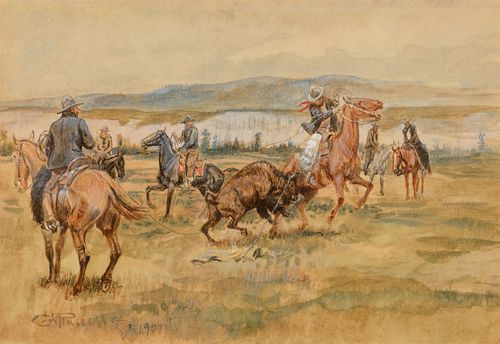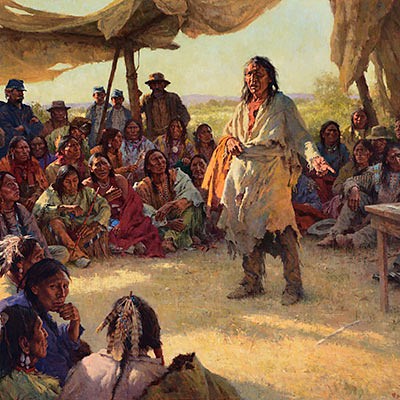Charles M. Russell (1864 – 1926) — Pablo Buffalo Hunt (1909)
About Seller
11944 North Tracey Road
Hayden, ID 83835
United States
Coeur d’Alene Art Auction specializes in the finest classical Western and American Art representing past masters and outstanding contemporary artists. The auction principals have over 100 years of combined experience in selling fine art and have netted their clients over $325 million in the last fif...Read more
Two ways to bid:
- Leave a max absentee bid and the platform will bid on your behalf up to your maximum bid during the live auction.
- Bid live during the auction and your bids will be submitted real-time to the auctioneer.
Bid Increments
| Price | Bid Increment |
|---|---|
| $0 | $100 |
| $2,000 | $250 |
| $5,000 | $500 |
| $10,000 | $1,000 |
| $20,000 | $2,500 |
| $50,000 | $5,000 |
| $100,000 | $10,000 |
| $200,000 | $25,000 |
| $500,000 | $50,000 |
| $1,000,000 | $100,000 |
About Auction
Jul 15, 2023
The 2023 Coeur d’Alene Art Auction, to be held July 15 in Reno, Nevada, will feature 324 selections of unparalleled quality in Western & American Art from historical and contemporary artists such as Maynard Dixon, Howard Terpning, W. Herbert Dunton, Joseph H. Sharp, Charles M. Russell, and more. Coeur d'Alene Art Auction info@cdaartauction.com
- Lot Description
Charles M. Russell (1864 – 1926)
Pablo Buffalo Hunt (1909)
watercolor on paper
7.5 × 11.5 inches
signed and dated lower left
Pablo Buffalo Hunt is recorded in the C. M. Russell Catalogue Raisonné as reference number CR.UNL.412.
According to Russell biographer Dr. Larry Len Peterson, “The Pablo Buffalo Roundup was one of the quintessential experiences of Charles M. Russell’s artistic life. His ability to capture the bison in paint and sculpture significantly improved as a result of his participation in the event. Russell studied the wooly beast more closely than any other artist and immortalized the celebrated legend of the plains in oil, watercolor, clay, bronze, and nostalgic prose and poetry. The bison, symbol of the American West, inspired Russell to create his famous cipher and his most desirable art, the buffalo hunt. The species name for the American bison is Bison bison, often popularly called buffalo. In 1881 the Blackfeet had their last great hunt, bringing in 150,000 animals. With the commercial hunters killing another 320,000 buffalo, the animals were headed toward extinction. The killing came to an end in 1883, when the Blackfeet netted their last six animals.
“In 1907 the Pablo Buffalo Roundup would rescue one of the last herds, which roamed the land below Flathead Lake in northwestern Montana, south of Glacier National Park. After Michel Pablo of mixed-blood Flathead heritage had unsuccessfully attempted to sell his herd to the U.S. government, the Canadian government in 1907 stepped in and agreed to buy 700 head for $200,000, over $6 million in today’s money.
“Preparations soon were underway for the roundup. Heavy chutes and twenty-four-inch-wide timber corrals were built at the railroad yards at Ravalli, Montana. Pablo had hoped to have the bison rounded up in a few months, but they proved to be formidable adversaries. Fewer than one-hundred were corralled in 1907 – it would not be until 1912 that the last of the herd was shipped to Canada. With disappointing results the first year, a twenty-six-mile-long fence was built from the grazing area to the shipyards, and smaller corrals were built within the fence. The Pend Oreille River – now called the Flathead – and its cliffs were used as a natural barrier, with the assistance of log booms, to prevent the bison from swimming away. The captives were shipped by rail to their final destination. More than seventy-five riders took part in the extravaganza and for their hazardous work were paid $5 a day and chow.
“Howard Douglas, commissioner of Dominion Parks at Banff, invited Russell to attend the thrilling 1908 and 1909 roundups. While the commissioner was pleased to have him there and enjoyed his company, he hated his cooking, especially the boiled beef and dumplings – it was the source of many jokes over the years. In November 1908 Charlie made his way to his first roundup. Pablo Buffalo Hunt (1909), is one of a handful of historically significant watercolors the artist painted on site – perhaps his most intimate. Russell posed in his tent for Canadian photojournalist M. O. Hammond who snapped him painting one of them.
“Even though Russell was a spectator in the November 1908 roundup, the next spring he was an active participant. In this gem, Russell not only memorializes the courage of the cowboy and bison, but also friendships made at the roundup. His friend Butte photographer Norman Forsyth produced sixty-six stereographs in a box set distributed by Underwood and Underwood Vu, which captured this unique and spectacular event. From those images we can identify the main characters featured in this unforgettable piece. From left to right: Dunc McDonald, a mixed blood Flathead rancher and a clerk for the Hudson’s Bay Company; Russell taking in the excitement in the background; Howard Douglas; and at the center, Alex Ayote (in his white, wooly chaps shown being charged by an angry bison), the Canadian immigration agent in Montana who supervised the transfer of the bison; along with two onlookers. In the far background is the Pend Oreille River and the dramatic, white cliffs. While having the bull attack Ayote, the ‘change’ agent, gave his camp mates a good laugh, Russell’s wonderfully charismatic composition was a poignant way of expressing his nostalgia for the days when the great bison herds roamed free and the land belonged to God.”
PROVENANCE
Sak’s Galleries, Denver, Colorado
Collection of Lisa Ann Adams Stinson, Huntington Beach, California
Coeur d’Alene Art Auction, Reno, Nevada, 2009
Private collection
LITERATURE
Larry Len Peterson, Charles M. Russell, Photographing the Legend: A Biography in Words and Pictures, University of Oklahoma Press, 2014, pp. 103-11
Larry Len Peterson, Blackfeet John L. “Cutapuis” Clarke and the Silent Call of Glacier National Park: America’s Wood Sculptor, Sweetgrass Books, 2019, p. 324, illustrated
Larry Len Peterson, The American West Reimagined: Gems from the Coeur d’Alene Art Auction, Coeur d’Alene Art Auction, 2021, p. 119, illustrated
View More InformationCondition
As viewed through glass. Paper appears to be in good condition.
- Buyer's Premium



 EUR
EUR CAD
CAD AUD
AUD GBP
GBP MXN
MXN HKD
HKD CNY
CNY MYR
MYR SEK
SEK SGD
SGD CHF
CHF THB
THB













